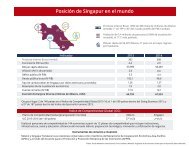basic-guide-to-exporting_Latest_eg_main_086196
basic-guide-to-exporting_Latest_eg_main_086196
basic-guide-to-exporting_Latest_eg_main_086196
Create successful ePaper yourself
Turn your PDF publications into a flip-book with our unique Google optimized e-Paper software.
Often, the first company does not produce all the products that it is under contract<strong>to</strong> provide, and it turns <strong>to</strong> other U.S. companies <strong>to</strong> provide the re<strong>main</strong>ing products.The second U.S. company then piggybacks its products on<strong>to</strong> the internationalmarket, generally without incurring the marketing and distribution costs associatedwith <strong>exporting</strong>. Successful arrangements usually require that the product lines becomplementary and appeal <strong>to</strong> the same cus<strong>to</strong>mers.Direct ExportingThe advantages of direct <strong>exporting</strong> for your company include more control over theexport process, potentially higher profits, and a closer relationship <strong>to</strong> the overseasbuyer and marketplace, as well as the opportunity <strong>to</strong> learn what you can do <strong>to</strong> boos<strong>to</strong>verall competitiveness. However, those advantages come at a price; your companyneeds <strong>to</strong> devote more time, personnel, and resources <strong>to</strong> direct <strong>exporting</strong> than itwould <strong>to</strong> indirect <strong>exporting</strong>.If your company chooses <strong>to</strong> exportdirectly <strong>to</strong> foreign markets, it usuallywill make internal organizationalchanges <strong>to</strong> support more complexfunctions. As a direct exporter, you’llnormally select the markets you wish<strong>to</strong> penetrate, choose the best channelsof distribution for each market, andthen make specific connections withoverseas buyers in order <strong>to</strong> sellyour product.Direct <strong>exporting</strong> allows morecontrol over the export process,potentially higher profits, and acloser relationship <strong>to</strong> the overseasbuyer and marketplace—as well asan opportunity <strong>to</strong> learn how you canboost your overall competitiveness.Getting Organized for ExportingA company new <strong>to</strong> <strong>exporting</strong> generally treats its export sales no differently fromits domestic sales, using existing personnel and organizational structures. Asinternational sales and inquiries increase, your company may choose <strong>to</strong> separate themanagement of its exports from that of its domestic sales.Advantages of separating international from domestic business include thecentralization of specialized skills needed <strong>to</strong> deal with international markets and thebenefits of a focused marketing effort that is more likely <strong>to</strong> increase export sales.However, s<strong>eg</strong>mentation is sometimes a less efficient use of company resources.Your company can separate international from domestic business at different levelsin the organization. For example, when you first b<strong>eg</strong>in <strong>to</strong> export, you may createan export department with a full- or part-time manager who reports <strong>to</strong> the head ofdomestic sales and marketing. At a later stage, your company may choose <strong>to</strong> increasethe au<strong>to</strong>nomy of the export department <strong>to</strong> the point of creating an internationaldivision that reports directly <strong>to</strong> the president. Many smaller companies absorb exportsales in<strong>to</strong> existing functions; such an arrangement works effectively until export salesincrease significantly—a happy challenge <strong>to</strong> look forward <strong>to</strong>.64U.S. Commercial Service • A Basic Guide <strong>to</strong> Exporting





